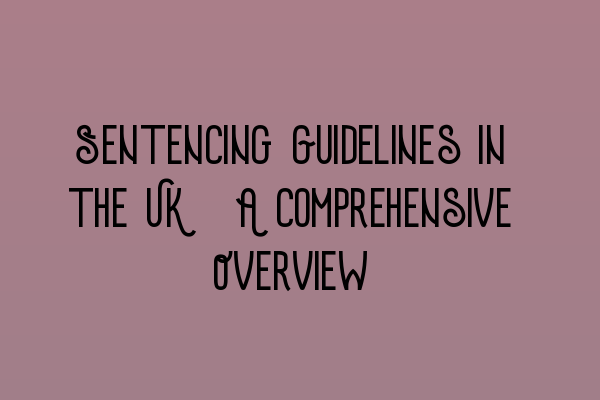Sentencing Guidelines in the UK: A Comprehensive Overview
As criminal solicitors at SQE Criminal Law & Practice Law UK, we understand the importance of sentencing guidelines
in the United Kingdom’s legal system. Sentencing plays a crucial role in determining appropriate punishments for
criminal offenses, ensuring justice is served and promoting a fair and consistent approach across the country.
Sentencing guidelines provide judges and magistrates with a framework to consider various factors when determining
the appropriate sentence for a particular offense. These guidelines take into account the seriousness of the offense,
the harm caused, the culpability of the offender, and any aggravating or mitigating factors. By following these
guidelines, courts aim to strike a balance between punishment and rehabilitation.
Understanding the Purpose of Sentencing Guidelines
Sentencing guidelines serve multiple purposes within the UK’s criminal justice system. Firstly, they provide consistency
and predictability. When similar offenses are treated similarly, it ensures fairness and prevents arbitrary decision-making.
This helps in building public confidence in the legal system.
Secondly, sentencing guidelines contribute to transparency. They offer clear directives to judges and magistrates,
ensuring they consider relevant factors while reaching a decision. This transparency allows the public to understand
the rationale behind specific sentences, thereby promoting accountability in the criminal justice system.
Lastly, sentencing guidelines take into account the principle of proportionality. The punishment should be proportionate
to the seriousness of the offense committed. By outlining different sentence ranges for various offenses, the guidelines
help in achieving this fundamental principle.
Types of Sentencing Guidelines
In the United Kingdom, there are two primary types of sentencing guidelines: statutory guidelines and guideline
judgments. Statutory guidelines are created by Parliament and provide general principles for judges and magistrates
to follow. On the other hand, guideline judgments are issued by senior courts and provide specific guidance for particular
offenses or categories of offenses. Together, these guidelines form a comprehensive framework for the judiciary to
ensure consistent and fair sentencing.
Importance of Staying Updated with Sentencing Guidelines
As legal professionals, it is essential to stay up-to-date with the latest sentencing guidelines. Changes in legislation
and evolving societal attitudes can lead to amendments in sentencing guidelines. By understanding these changes, solicitors
can provide accurate advice to their clients, negotiate plea deals effectively, and anticipate potential outcomes in
court. It is crucial to continually access and refer to the Sentencing Council’s website to remain informed about any
updates or new guidelines.
At SQE Criminal Law & Practice Law UK, our team of experienced solicitors regularly consults the most recent sentencing
guidelines to provide our clients with the best possible representation. We are committed to staying informed about
changes in sentencing practices and ensuring our clients receive fair and just treatment.
Conclusion
Sentencing guidelines play a vital role in the UK’s criminal justice system, providing a framework for determining
appropriate punishments. They promote consistency, transparency, and proportionality in sentencing, ensuring fairness
and public confidence. As legal professionals, it is crucial to stay updated with the latest guidelines to provide
the best possible representation to clients.
If you would like to learn more about criminal law and practice in the UK, please check out our related articles:
SQE 1 Practice Exam Questions,
SQE 1 Practice Mocks FLK1 FLK2,
SQE 2 Preparation Courses,
SQE 1 Preparation Courses, and
SRA SQE Exam Dates.
